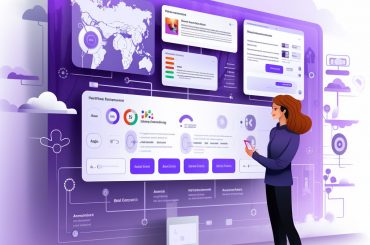Project management is a complicated task. It becomes even more complex when multiple departments have to collaborate on a project since each department has its work methodology that they are comfortable working with to deliver desired results. This significantly complicates inter-departmental project management, owing to significant variations in processes and methods.
Project management can also be complicated for large projects with various moving parts that have to be aligned. Without seamless alignment of all moving parts, it becomes challenging to keep up with the project efficiency, becomes less productive, and even comes to a halt.
That’s where project integration management comes to the rescue.
Project integration management is meant to streamline working processes between various departments and align all moving parts involved in the project.
What Is Project Integration Management?
The essence of project integration management is to streamline all processes involved in project management. To put it simply, project integration management ensures that all processes used in a project are aligned and work in coordination with respect to each other to achieve higher efficiency and productivity.
However, project integration management only achieves this by making trade-offs. This means that you may not achieve everything if you are looking to complete the project timely and within budget. A standard operational procedure of all project managers is finding alternatives to fulfill stakeholders’ expectations when there are competing objectives.
There are various processes involved in project integration management, including; identification, defining, merging, and streamlining various processes and procedures involved in the project management process. This means that project managers need to make choices regarding resource allocations and trade-offs, to manage the interdependencies involved in the project management knowledge areas.
Importance of Project Integration Management
As mentioned above, project management is a complex task since various processes and moving parts need to be managed simultaneously. For instance, in a typical project, a project manager is required to handle all of the following;
- Scheduling
- Budgeting
- Scoping
- Quality assurance
- Resource allocation
- Risk management
- Change management
- Stakeholders
Managing all of these aspects simultaneously while also tracking the interdependencies and impacts of each factor over the other can be very challenging. Failure to keep up with all of these factors can lead to project failures. For instance, the project manager needs to realize how the project’s scope will impact the cost or project timeline. The decisions you make for a project also influence other areas of the business and other projects. For instance, project managers need to identify various impacts, including cost and timeline, if suddenly there is a need to hire a specialized human resource for a couple of months. Without project integration management being implemented across the business, it can be almost impossible to identify conflicts and quantify impacts on the project.
Project integration management processes
To streamline all project processes, a number of deliverables have to be created by project integration management. Below are some of the processes involved in the project integration management;
Project Charter
The project charter is the authority to initiate the project and includes the primary roles and responsibilities of the project. The project charter also consists of the scope and objectives of the project, as well as the appointment of a project manager. In essence, the Project Charter is the reference document for any project that moves it forward.
A project charter is intentionally created generic enough to make it difficult to change it throughout the project lifecycle. The charter is usually written by the manager or project manager.
Scope Statement
The next process involved in project integration management is the scope statement. Unlike the project charter, the scope statement isn’t written on the stone; instead, it is flexible enough to be revised and edited when and where required during the project lifecycle.
The scope statement identifies what is included and what is not included in the project. The document consists of all the work that has to be completed over the project’s life. In simple words, the scope statement defines the deliverables and key performance indicators to measure the project’s success.
Project Management Plan
The project management plan is the collaborating document that outlines how various processes can work together to achieve greater efficiency and increased productivity. The project management plan document also includes the project charter, albeit it also includes more details for the goals, costs, scheduling, approaches, resources required to complete the project efficiency, as well as risk assessment. In essence, the project management plan is a guideline that helps project managers efficiently control and execute the project.
The project manager creates the project management plan, which will subsequently consolidate all complementary plans, including quality management plans, scope management plans, human resource plans, cost management plans, process improvement plans, procurement management plans, communication plans, and others. The document also details the baselines for various processes like scope baseline, schedule baseline, budget baseline, and others. The baselines set in the project management plan can only be changed through a formal request.
Direct and Manage Project Work
Once the plans are ready, it’s time to execute and manage the project. At this stage, the project is being controlled to produce planned deliverables as detailed in the project management plan. At this stage, the key task is to handle the technical parts of the project and ensure the smooth execution of work. The project execution phase can be categorized into three parts: implementation, management, and reporting.
This process also involves change management, which may be required to increase the efficiency of project work. Also, various environmental impacts are considered, and the assessment of organizational process assets is being performed.
Monitor and Control Project Work
Monitoring and controlling of project work, including change management and management of processes, tools, and techniques, comes under the project monitory and control process.
As mentioned earlier, project management plans can be changed by formally requesting the change anytime during the project lifecycle. However, such changes and their impacts need to be monitored and controlled closely to ensure no compromises are made to the quality of the project. Thereby, a dedicated resource is often deployed to oversee change implementation, management and control.
All change requests that may arise during this phase are carefully assessed, controlled, and documented. A change control board is tasked to evaluate the change requests for approvals or disapprovals. The project manager, on its part, will perform due diligence to ensure that the project is not moving away from the agreed plan.
Project Close
The last process involved in the project integration management is closing the project once it is completed. The project close process involves reviewing all the processes used during the project execution and rating them for performance evaluation. It’s important to document each and every detail of the project as a reference for future projects.
Project integration management steps
The steps involved a set of control access points to be monitored and supervised by project managers. These steps include;
- Initiation
At this step, the project is formally handed over for the work initiation. At this step, the project manager receives all the necessary information required to initiate the project. The outcome of the initiation step includes the development of the project charter, identification of key stakeholders, and other essential plans needed to manage the stakeholders.
Inputs involved in the initiating Step include;
- Business needs
- Project Scope
- Project objective
- Project scheduling
- Project budgeting
- Project completion information
- Risk assessment information
- Project acceptance criteria
- Allocated resources (team members)
- Authority rested upon the project manager
- Planning Step
During the planning Step, the project manager develops the project blueprint that clearly identifies and defines all necessary project guidelines, including schedules, budgeting, milestones, and other information required for smooth project execution.
Some of the essential processes that come under the planning Step includes;
- Scope management
- Cost management
- Risk management
- Quality management
- Stakeholder management
- Schedule management
- Resource management
- Procurement management
- Execution Step
During this step, the project is executed as per the blueprints defined in the above Step. This is a crucial step where the project manager is responsible for keeping a check on all project deliverables and ensure meeting the stakeholders’ expectations.
- Closing Step
During this step, the project is closed after successful completion. Just like other steps, it’s a crucial step where the key objective is to deliver the final projects to stakeholders along with necessary reports. Also, a critical requirement for the closing Step is to document all the findings of the project to be used as a ready reference for future projects.
Conclusion
In today’s competitive world, keeping an eye for each and every project detail is essential to keep the competitive advantage. With the various processes and parts involved in a project, executing, controlling, and managing all required tasks can be challenging for project managers. Project integration management assists managers in implementing an effective strategy by considering all important aspects of the project to achieve higher efficiency and maximum productivity for businesses.





